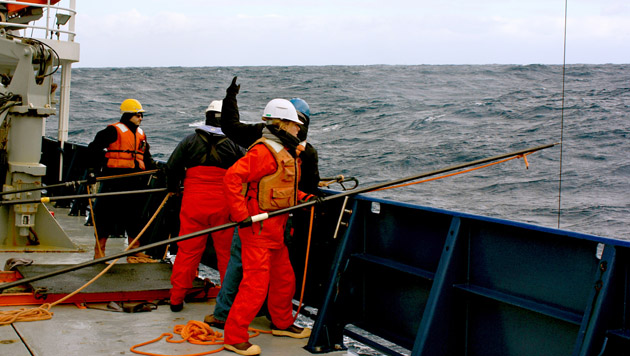Posted in:
Under-Researched Marine Organisms Play Larger than Life Role in Ocean Chemistry

Earlier this year, scientists wrapped up the second research cruise, as part of a multi-year project investigating a feature of the Southern Ocean known as the Great Southern Coccolithophore Belt (Great Belt). Coccolithophores are a type of phytoplankton with a unique exoskeleton composed of calcified platelets (coccoliths), giving them the appearance of being heavily armored.
During the calcification process, carbon is incorporated into the coccoliths; as the organisms die and sink to deeper waters, their calcite skeletons either re-dissolve into the seawater or become incorporated into the ocean sediments, thus acting as carbon “sinks.” They also help organic carbon from recently living cells sink to the deep sea by removing carbon from the surface waters. Combined with their global abundance, these functions make coccolithophores an important component of the global carbon cycle.
The ocean absorbs roughly one-quarter of the CO2 released into the atmosphere every year. As atmospheric CO2 levels increase, so does the amount absorbed by the ocean. This rapidly increasing level of ocean CO2 reduces the ocean’s pH in a process called ocean acidification. Reduced pH can slow or prevent organisms, including coccolithophores and corals, from building their calcium carbonate shells and skeletons. This, in turn, could have significant consequences for the ocean’s marine life, as plankton form the base of the marine food chain.
Despite having a high concentration of coccolithophores, the Great Belt—which stretches around the entire Southern Ocean and comprises 26% of the world’s ocean—remains an under-studied region. The team of 23 scientists set out to change this by undertaking a systematic look at the region’s coccolithophores, as well as what factors/processes influence their abundance and distribution.
Among the scientists on board was Rebecca Garley, Research Technician in Dr. Nick Bates’ Marine Geochemistry Lab at BIOS. Using the same instrumentation as in the lab, Garley measured the dissolved inorganic carbon (DIC) and total alkalinity in the cruise’s water samples collected from the surface waters down to depths of 6,000m. These data allow Garley to calculate pH, partial pressure of carbon dioxide(pCO2) and other parameters of seawater chemistry that help determine the state of the oceans.
Now back on land, Garley is re-running the samples collected during the cruise to compare the quality of the data using the instrumentation at sea with that in the Marine Geochemistry Lab. She hopes to work with the cruise’s Chief Scientist, Dr. William “Barney” Balch at the Bigelow Laboratory for Ocean Sciences, to combine their data sets in an effort to determine coccolithophore distribution, their role in the global carbon cycle and how ocean acidification may impact coccolithophores.
Tagged: